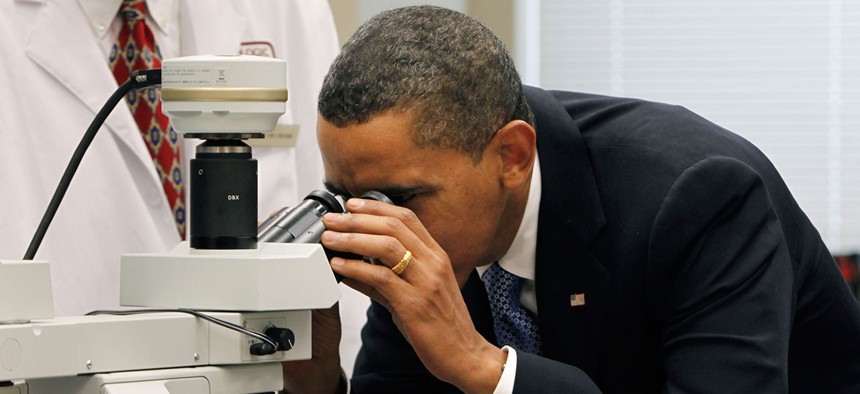White House Launches the National Microbiome Initiative
Half a billion dollars are being pledged to study the microbes in humans, crops, soils, oceans, and more.
Last October, we ran a story titled “Hey Obama, Can We Have a Unified Microbiome Initiative? Yours, the microbiologists.”
As it happens, the answer is yes.
Today, the White House is announcing the launch of the National Microbiome Initiative (NMI)—an ambitious plan to better understand the microbes that live in humans, other animals, crops, soils, oceans, and more. These miniscule organisms are attracting mammoth budgets: federal agencies are committing $121 million to the NMI over the next two years, while more than 100 universities, non-profits, and companies are chipping in another $400 million.
Essentially, America has decided to point half a billion microscopes at the planet, and look through them.
Note the “planet” bit. There’s a tendency of read “microbiome” and automatically see “human” before it. But that’s a narcissistic view. If you condense the Earth’s history into a single calendar year, then bacteria have been around since March and humans since 11:30 p.m. on December 31. From a microbe’s point of view, we are just another ecosystem, and a relatively new one at that. “If we just look at the human microbiome, we’re missing out on a lot of biology,” says Jo Handelsman, a pioneer of the modern microbiome science and the associate director for science at the White House Office of Science and Technology Policy.
Much of that biology is relevant to us. Soil microbes affect the viability of our farmlands. Plant microbes affect the yield of our crops. Oceanic microbes affect the circulating of oxygen, carbon, and other nutrients around the entire planet. The microbes of our buildings influence our exposure to disease-causing species. All of these are as important to us as the gut microbes that more directly affect our risk of obesity or inflammatory bowel disease.
There are also important parallels between these communities. A coral reef being overrun by algae is not dissimilar to an inflamed gut, while swallowing antibiotics is a bit like unleashing crude oil upon the Gulf of Mexico. “You’re perturbing an ecosystem, seeing a change, and not being able to interpret that change,” says Handelsman. “The same questions are being asked about many microbiomes. What’s a healthy one? What’s normal? How do we change them? These are things people think about in oceans, lakes, soil, and people. The principles underlying the answers are probably common.”
So the National Microbiome Initiative is actively trying to create links between scientists who are currently working within centuries-old academic buckets. For example, the National Institutes of Health will commit $20 million towards projects that draw comparisons between different ecosystems. The Bill and Melinda Gates Foundation is investing $100 million in fighting childhood malnutrition and crop diseases by manipulating the respective microbiomes of guts and soils. One project talks about probiotics and microbiome transplants, but in the context of industrial plants, heat exchangers, and water treatment facilities.
The National Microbiome Initiative is not the Human Genome Project—a single project with a definitive goal. It consists of many organizations operating independently; to paraphrase Whitman, it contains multitudes.
In some ways, it looks like everything old is new again. There are projects looking at human disorders, including obesity, type 1 diabetes, cancer, multiple sclerosis, Alzheimer’s disease, and tooth decay. There are schemes to see how the microbiome changes in childhood, during old age, or under different diets. There are plans to develop new probiotics. A cynic might be forgiven for seeing this as an exercise in branding, encapsulating what microbiome scientists were already doing under a catchy umbrella.
Then again, the NMI does have three well-chosen themes that underlie its smorgasbord of projects. The first, as I’ve mentioned, is collaboration. Dozens of universities are launching new microbiome research centers and faculty positions designed to bring disparate microbe aficionados together.
The second involves developing better tools for studying microbiomes. As I wrote in my last piece, this will include techniques that can analyze the entire genomes of specific microbes; track the movements of molecules between or within cells; and add, remove, edit, stimulate, or block specific species with precision. That will allow microbiologists to accurately simulate communities of microbes, predict how they will change over time, and then modify them accordingly.
The third theme is recruitment. “The microbiome is so variable that the scientific community will never be able to sample every environment on earth,” says Handelsman. But by involving college students and citizen scientists, “we could have hundreds and thousands of people gathering data, and doing highly replicated experiments in different classrooms.” So the NMI also includes workshops, new career tracks, community projects (like a Microbiome Wikipedia edit-a-thon), and educational resources (disclosure: one of these involves a studio that has optioned the rights to develop films based on my upcoming book).
All of this will be announced at an event at the White House later today. “The public has suddenly become so interested in microbiomes in the last couple of years,” says Handelsman. “I think it’s important for them to know that the government has responded to that interest. But we’re not done with the microbiome after that.”
The launch event will bring together a wide coterie of scientists, industry representatives, and funding agencies. That seems fitting. If microbiome science tells us anything, it’s that everything is secretly ecology. The biology of oceans and bodies and soils is really about the connections and relationships between living things, many of which have gone unnoticed for too long. It will take new human relationships to understand them.



